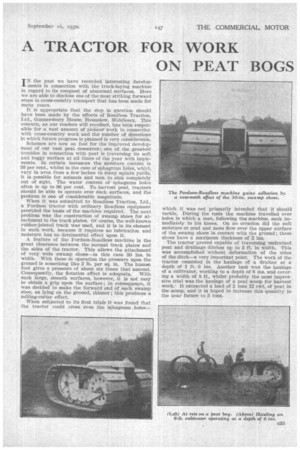A TRACTOR FOR WORK ON PEAT BOGS
Page 57

If you've noticed an error in this article please click here to report it so we can fix it.
TIN the past we have recorded interesting develop meats in connection with the track-laying machine in regard to its conquest of abnormal surfaces. Here we are able to disclose One of the most striking forward steps in cross-country transport that has been made for many years.
It is appropriate that the step in question should have been made by the efforts of Roadless Traction, Ltd., Gunnersbury House, Hounslow, Middlesex. This concern, as our readers will recollect, has beeit responsible for a vast amount of pioneerwork in Connectior with cross-country work and the number of directions in which future progress is planned is very considerable.
Schemes are now on foot for the improved development of our vast peat resources; one of .the_ greatest. troubles in connection with peat is traversing its soft and boggy surface at all times of the year with implements. In certain instances the moisture content is 93 per cent., whilst in the case of sphagnum holes, which vary in area from a few inches to .Many square yards; it is possible for animals and men to sink completely out of sight. The water content Of sphagnum holes often is up to 96 per cent. To harvest peat, tractors Should be able to operate over such surfaces, and the problem is one of considerable magnitude. • When it was submitted to Roadless Traction, Ltd.,
Fordson tractor with ordinary Roadless equipment provided the basis of the machine required. The next problem was the construction of swamp shoes for attachment to the track plates. Of course, the well-known rubber-jointed track was used, and it is in its element in such work, because it requires no lubrication and moisture has no detrimental effect upon it.
A feature of the Fordson-Roadless machine is the great clearance between the normal track plates and the sides of the tractor. This allows the attachment of very wide swamp shoes—in this case 30 ins, in width. With these in operation the pressure upon the ground is something like 2 lb. per sq. in. The human foot gives a pressure of about six times that amount. Consequently, the flotation effect is adequate. With such large, smooth surfaces, however, it is not easy to obtain a grip upon the surface; in consequence, it was decided to make the forward end of each swamp shoe, as lying on the ground, thinner ; this produces a milling-cutter effect.
When subjected to its first trials it was found that the tractor could cross even the sphagnum holes—
which it was not primarily intended that it should tackle. During the tests the machine travelled over holes in which a man, following the machine, sank immediately to his knees. On no occasion did the soft moisture or mud and moss flow over the upper surface of the swamp shoes in contact with the ground ; these shoes have a maximum thickness of 2 ins,
The tractor proved capable' of traversing undrained peat and drainage ditches up to 3 ft. in width. This was accomplished without deformation of the sides of the ditch—a very important point. The work of the tractor consisted in the haulage of a drainer at a depth of 1 ft. 6 ins. Another task was the haulage of a cultivator, working to a depth of 6 ins, and covering a width of 8 ft., whilst probably the most impreAsire trial was the haulage of a peat scoop for harvest work.' It extracted a load of 2 tons 12 cwt, of peat in the scoop, and it is hoped to increase this quantity in the near future to .3 torts.












































































































